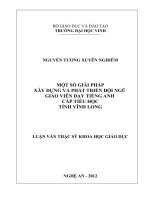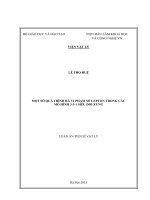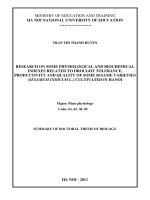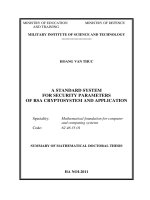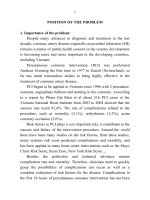một số quá trình rã vi phạm số lepton trong các mô hình 3-3-1 siêu đối xứng bản tóm tắt tiếng anh
Bạn đang xem bản rút gọn của tài liệu. Xem và tải ngay bản đầy đủ của tài liệu tại đây (545.76 KB, 26 trang )
MINISTRY OF
EDUCATION AND TRAINING
VIET NAM ACADEMY OF SCIENCE
AND TECHNOLOGY
INSTITUTE OF PHYSICS
LE THO HUE
LEPTON FLAVOR VIOLATING DECAYS IN SUPERSYMMETRIC
3-3-1 MODELS
Major subject: Theoretical and mathematical Physics
Code: 62 44 01 01
THE SUMMARY OF THE DOCTORAL DISSERTATION
HA NOI - 2013
The research was finished at:
INSTITUTE OF PHYSICS,
VIET NAM ACADEMY OF SCIENCE AND TECHNOLOGY
Supervisor : Prof. Dr. Hoang Ngoc Long
Institute of Physics, Viet Nam Academy of Science and Technology
Referee 1:
Prof. Dr Tran Huu Phat
Referee 2: Prof. Dr. Nguyen Xuan Han
Referee 3:
Assoc. Prof. Dr. Phan Hong Lien
This dissertation will be defended in front of the evaluating assembly at academy
level
Place of defending: meeting room, floor
, Institute of Physics, Viet Nam
Academy of Science and Technology.
No 10, Dao Tan, Ba Dinh, Ha Noi
Time: at…… …..day….. month……. year……..
This thesis can be studied at the Vietnam National Library or
at Library of the National Academy of Public Administration
Introduction
Urgency of the topic
Particle physics are now strictly related with high energy colliders. All models are waiting for experimental significance of
New Physics to compare with all predictions as well as limiting
parameter space of each model. Specially, in the last 2012 and
early 2013 the Large Hadron Collider (LHC), placed in CERNSwitzerland with two independent detectors CMS and ATLAS,
has discovered a new scalar particle inheriting many properties
of Higgs (Higgs-like) predicted by the Standard Model (SM) with
mass around 125-126 GeV. This is the last type of particle contained in SM which has already found by recent experiments. In
the coming time, when energy of LHC increases up to 14 TeV,
physicists hope the appearance of New Physics significance beyond SM. In particular, there may be Lepton Flavor Violating
(LFV) decays of normal leptons. Until now, SM is still the most
successful model predicting all current experimental results except the experiments of neutrino oscillations. They prove that
neutrinos indeed have non-zero but very small masses and there
appear the conversions among them. This confirms that SM is
still an effective theory of some more general theory. The conversions among neutrinos gives an clear evidence for the LFV
in the world of fundamental particles. Therefore, one hopes that
these effects may happen in the charged lepton sector. While the
Lepton Flavor (LF) numbers are absolutely conserved in the SM
1
framework, then cLFV decays, if happen, will be a clear evidence
of New Physics. It was proved that the simplest model beyond
SM, the Standard Model with right-handed neutrinos, has very
suppressed cLFV effects that cannot be detected by recent experiments. On the other hand, the minimal supersymmetric Standard Model (MSSM) which is the most attractive model studied
by both theory and experiment, contains many interesting cLFV
effects. The model is also the simplest supersymmetric model
with the least new particles as well as parameters. Many publications for MSSM confirm that cLFV significance can be happen
in colliders such as LHC. In addition, some cLFV decays, such
as cLFV decays of tauon , have limited the parameter space of
this model, excluded many regions containing light superpartners. This leads to the consequence that these superparticles are
out of the detection of recent experiments. For the supersymmeetric 3-3-1 (SUSY331) models, it is also necessary to predict
and investigate the parameter space in order to compare with
other models and experimental bounds. This is the main reason why we concentrate on the study of the cLFV decays in the
SUSY331 models and publish obtained results in this dissertation. We will consider two models supersymmetric economical
3-3-1 (SUSYE331) and supersymmetric reduced minimal 3-3-1
(SUSYRM331) models.
Research purpose
• We construct the SUSYRM331.
• We study the lepton flavor violation in the SUSYE331 model
through decays of Higgs, tau and Z boson.
Research object
• LFV verteices in the SUSYE331 and SUSYRM331.
2
• cLFV decays of H→ μτ , τ → μγ, τ → 3μ and Z → μτ in
the SUSYE331.
Research content
• The supersymmetric reduced minimal 3-3-1 model.
• Properties of LFV vertices in SUSY331 models
• The possibility of detection decay H→ μτ in recent colliders
• Discussing on regions of parameter space of SUSYE331 satisfying the experimental bounds.
Research method
• Quantum field theoretical method.
• Numerical investigation by Mathematica 7.0.
Dissertation Structure
The dissertation contains the introduction, four chapters presenting main content and the conclusion listing all of new results
of our works. In addition, the dissertation contains three more
appendices which show in detail all necessary analytic formulas and computations. The first chapter summaries properties of
the 3-3-1 models, discusses on the LFV property of these models
and the basis of the supersymmetric theory. The second chapter
concentrates on two models SYSYE331 and SUSYRM331. For
SUSYE331, we just discuss on the LFV vertices which are the
LFV sources creating all LFV decays considered in the next chapters. The remain part of this chapter involves with constructing in
detail the SUSYRM331 and the LFV vertices in the soft term of
the model. Two chapters three and four directly investigate some
particular LFV decays in the frame work of the SUSYE331.
3
Chương 1
Review of 3-3-1 models
The original 3-3-1 models are the minimal 3-3-1 (M331) and the
3-3-1 model with right-handed neutrinos. These models are constructed by extending the SU(2)L gauge group in the SM to
SU(3)L group. A common property of these models are the appearance of LFV effects in the original structures them selves.
1.1
The 3-3-1 model with right-handed neutrinos
In this model, the SU(2)L group was extended SU(3)L by adding
a right-handed neutrino to the bottom component of each lepton
triplet. In the quark sector, new quarks appearing as third components of quark (anti) triplets are called exotic quarks, with the
lepton number L = 2. One needs three Higgs (anti)triplets to generate masses of particles. Because neutrinos and anti-neutrinos
are in the same triplets then the lepton numbers are not conserved. This is the common property of the 3-3-1 models. But
these models relate with a new conserved number called extended
lepton number, denoted L. It can be computed from the original
L number by a formula
2
(1.1)
L = √ λ8 + LI.
3
4
More detail, the table 1.1 lists particular values of L and baryon
number B = BI of multiplets contained in the considered model.
In addition, table 1.2 presents numerical values of components of
all multiplets.
Bảng 1.1: Values of B and L for 3-3-1 models with right-handed
neutrinos.
Multiplet
B
L
χ
0
4
3
η
0
−2
3
ρ
0
−2
3
Q3L
1
3
−2
3
QαL
1
3
2
3
uaR
1
3
0
daR
1
3
0
TR
1
3
−2
DαR
1
3
faL
0
1
3
2
laR
0
1
Bảng 1.2: Non-rezo values of L for fields in the 3-3-1 models with
right-handed neutrinos.
Field
L
NL
−1
lL
1
lR
1
ρ+
3
−2
0
η3
−2
χ0
1
2
χ−
2
2
DαL
2
DβL
2
TL
−2
TR
−2
From table 1.2, we can see that neutral Higgses have zero values of VEVs unless they have L = 0. The number of neutral Higgses can be reduced if neutral Higgses with non-zero values of L
can get non-zero but enough small values of VEVs. Because LFV
is the natural property of the 3-3-1 models so this assumption is
allowed, provided VEVs are enough small to satisfy experimental
bounds. This is the idea of authors P.V Dong, H.N. Long, D.T.
Nhung and D.V. Soa to construct the economical 3-3-1 (E331)
model. This model contains many proper properties comparing
with other 3-3-1 models: The number of parameters are reduced,
VEV values are limited from experiment bounds, the LFV in the
neutral lepton sector can be explained,.... The simple property
of the Higgs sector in the E331 model is used to construct the
supersymmetric version which is widely investigated recently.
5
1.2
The minimal 3-3-1 model
The minimal 3-3-1 model (M331) model is constructed similar to
the cases of above 3-3-1 models. The difference is that all lepton
triplets are well-known leptons in the SM and there need not
any new leptons. But the Higgs spectrum in this model is rather
complicated because of the appearance of a Higgs sextet. Table
1.3 lists values of B và L for multiplets in the model. Note that
Bảng 1.3: Values of B and L in the M331.
Đa tuyến
Tích B
Tích L
χ
0
4
3
ρ
0
−2
3
η
0
−2
3
S
0
2
3
Q3L
QαL
1
3
2
3
1
3
−2
3
uaR
daR
TR
DαR
0
0
−2
2
1
3
1
3
1
3
1
3
faL
0
1
3
formula (1.1) is still true for this model. Table 1.3 shows that all
Higgses with non-zero VEVs all have L = 0.
Although the M331 does not need extra leptons such as righthanded neutrios, the Higgs spectrum is complicated and it is
hardly to find the exact mass eigenvalues of Higgses. Hence, supersymmetric versions constructed from this model always has
problems of Higgs diagonalization. Recently, a new model with
two Higgs triplets, called the reduced minimal 3-3-1 (RM331)
model, was introduced. The Higgs sector in this model is as simple as that of the E331, even the VEVs are fewer. The supersymmetric version, called the supersymmetric reduced minimal
(SUSYRM331) model, was also presented in 2013 by us and it is
reviewed in the chapter 2 of this dissertation.
6
Chương 2
Suppersymmetric 3-3-1
models
In this chapter, we concentrate on two supersymmetric models
constructed from two 3-3-1 models with the simplest Higgs spectrums, namely the E331 and RM331 models. The general basis
of the supersymmetric theory is not summarized here.
2.1
Supersymmetric economical 3-3-1 model
The SUSYE331 was introduced in 2007 as the supersymmetric
version of the E331. Similar to the case of MSSM, this model contains the double number of Higgs multiplets as those in the nonsupersymmetric model. In previous works studying the SUSYE331,
the LFV vertices in the soft terms are not considered. In this dissertation we assume that the LFV sources only appear in the soft
term of the lagrangian, namely
−Lμτ = (˜∗ , τL )
μL ˜∗
˜˜
+ (˜c∗ , τL )
μL ˜c∗
m2 L
˜μ
m∗2
˜ Lμτ
m2 R
˜μ
m∗2μτ
˜R
7
m2 μτ
˜L
m2L
˜τ
m2 μτ
˜R
m2R
˜τ
μL
˜
τ˜
L
μc
˜L
τL
˜c
.
(2.1)
Sleptons (˜L , τL ) and (˜c , τL ) are flavor eigenstates. We denote
μ ˜
μL ˜c
and ˜R , ˜R . The respective
l
l
l
mass eigenstates as ˜L , ˜L
l
2
(m2 2 ,
˜L
3
m2 3 )
˜L
2
(m2 2 ,
˜R
3
m2 3 ).
˜R
masses are
and
The mass eigenstates
are mixing of flavor eigenstates μ and τ . The mixing is quan˜
˜
titatively determined through new parameters sL and sR which
satisfy,
sL c L =
m2
˜ Lμτ
m2 3 − m2 2
˜L
˜L
,
sR c R =
m2
˜ Rμτ
m2 3 − m2 2
˜R
˜R
.
(2.2)
Eingenstates between two bases relate to each other by μL =
˜
˜L − sL ˜L , τL = sL ˜L + cL ˜L , where cL = cos θL , sL = sin θL ;
cL l 2
l 3 ˜
l 2
l 3
c
μc = cR lR2 − sR lR3 , τL = sR lR2 + cR lR3 . The lepton numbers are
L
conserved when sL = sR = 0. Similar to the case of sneutrino
sector, the mixing between flavor eigenstates is parameterized by
sνL and sνR . Four parameters sL , sR , sνL and sνR are four independent LFV sources, while the MSSM has only two independent
LFV sources. These sources will generate one-loop Feynman diagrams for cLFV decays considered in chapters 3 and 4.
2.2
Supersymmetric reduced minimal 3-31 model
The SUSYRM331 was constructed in 2013 by D.T. huong, L.T.
Hue, M.C. Rodriguez and H.N. Long (Nuclear Physics B 870
(2013) 293). Comparing with previous SUSY331s, the lepton and
Higgs spectrums is simpler. The lepton and Higgs (anti) triplets
are as simple as those in the RM331. In addition, this supersymmetric version contains doubly charged bosons, instead of the
non-hermitian neutral bosons in the SUSYE331. Both SUSYE331
and SUSYRM331 have some massless leptons and quarks at tree
level. Fortunately, recent works have indicated that the lepton
and quark masses at one-loop are suitable with experiments.
Therefore, these models are realistic and they need to investigate more about phenomenology.
8
If we concentrate on the LFV sources as those in the SUSYE331,
˜ ˜
we see that at tree level there is only one cLFV term m2 L† LLb .
Lab La
Also, this term relates with the measures of the neutrino oscillation experiments so we can estimate some constrains to these
parameters. This problems are being studied and we will publish
in the near future.
In summary, in this chapter we concentrate on two results
1. We parameterize the LFV mixing in the soft term of the
SUSYE331 when assuming the existence of this mixing in
slepton sector.
2. We constructed the SUSYRM331 and discuss on the LFV
sources of the model.
9
Chương 3
H→ μτ decays in the
SUSYE331
3.1
Effective operators and branching ratios
The low energy effective operators in the general case are used
from previous works. The branching ratios of neutral Higgses are
determined as
BR(Φ0 → τ + μ− ) = BR(Φ0 → τ − μ+ )
= 2(1 + tan2 γ) | Δρ |2 + | Δρ |2
L
R
× BR(Φ0 → τ + τ − ),
(3.1)
where tan γ is the ratio of two Higgs VEVs tγ ≡ tan γ = v/v ,
Δρ and Δρ are one loop effective LFV coefficients, Φ0 denote
L
R
the mass eigenstates of Higgses in the SUSYE331, Φ0 = ϕSa36
or φSa36 . Feynmann digrams presenting contributions to Δρ and
L
Δρ are shown in Fig. 3.1. The formulas are as follows,
R
Δρ
L
=
Δρ + Δρ + Δρ + Δρ + Δρ + Δρ + Δρ , (3.2)
La
Lc
Le
Lb
Ld
Lf
Lk
where Δρ , Δρ , Δρ , Δρ , Δρ , Δρ và Δρ receive one loop
La
Lc
Le
Lb
Ld
Lf
Lk
contributions from diagrams in Fig. 3.1. They are computed in
10
(a)
μ
˜Lα
l
λB
ρ0 ρ 0
˜ ˜
(b)
τc μ
ρ0∗
(d)
λ3
A
λ8
A
(e)
νRα
˜
ρ0 ρ 0
˜ ˜
νLα
˜
˜ ˜ ˜ ˜
τ c μ W +W − ρ+ ρ1− τ c
1
ρ0∗
ρ0∗
ν Lα
˜
˜ ˜ ˜ ˜
μ Y + Y − ρ+ ρ2− τ c μ
2
(c)
˜Lα
l
ρ+
˜2
ρ0∗
(f )
ν Rβ
˜
ρ2−
˜
ρ0∗
ν Rα
˜
ρ+
˜1
τc μ
ν Lβ
˜
ρ1−
˜
τc
ρ0∗
(i)
τ
(k)
˜Rα
l
ρ 0 ρ0
˜ ˜
˜Lα
l
λB
μc μ
ρ∗0
λB
(l)
˜R
l β
˜Lα
l
τc
τ
ρ∗0
λB
˜R
l β
μc
ρ0∗
Hình 3.1: Feynmann diagrams contribute to Δρ [(a), (b), (c), (d), (e), (f ), (k)] and
L
Δρ [(i), (l)].
R
the dissertation. They depend on only the function I3 (x, y, z)
where the precise formula is,
I3 (x, y, z) =
3.2
xy ln(x/y) + yz ln(y/z) + zx ln(z/x)
.
(x − y)(y − z)(z − x)
(3.3)
Numerical investigation
We just investigate the case of maximal mixing. The LFV decays Br(H → μτ ) are large when tan γ is large enough so we
choose tan γ = 50. Other parameters are assumed corresponding to the values shown in Figs. refFDeltaRhoR1, 3.3, 3.4, 3.5
and 3.6. These Figs. show that |Δρ |2 obtains the maximal value
R
˜
∼ 10−3 when |μρ |/mR is very large, the maximal values of |Δρ |2
L
11
are ∼ 5.10−3 when |μρ |/mL receive certain values. |μρ |/mL
˜
˜
1
ρ 2
−3 . Fig. 3.4 draws
then |ΔL | slowly approaches to the value of 10
the correlative ratio of left-handed and right-handed contributions to the branching ratio (3.1). This plot shows that |Δρ | is the
L
˜
dominant contribution when |μρ |/mL is small. |Δρ | gives large
R
contributions when |μρ |/mL are very large. To compare the cor˜
0.001
0.001
4
5
10
6
2
5
50 R
2
50 R
10
10
10
10
4
10
6
10
7
10
7
10
8
10
8
10
9
0
5
10
15
20
25
30
0
2
4
Μ Ρ mR
6
8
10
Μ Ρ mR
|Δρ |2 depends on |μρ |/mR . The respective parameters: 1) Blue–m =
˜
R
Hình 3.2:
mR = mL ; 2) green–3m = mR = mL ; 3) yellow- m = mR = 3mL ; 4) red–m =
˜
˜
˜
˜
˜
˜
˜
mR = mL /3. Two black lines correspond to two values 10−5 and 10−3 of |50Δρ |2 .
˜
R
The right (left) panel draws for 0 ≤ μρ /mSUSY ≤ 10 (0 ≤ μρ /mSUSY ≤ 30).
0.01
0.01
0.001
5
10
6
10
7
10
8
50 L
50 L
5
10
15
20
25
30
Μ Ρ mL
Hình 3.3:
4
10
5
6
10
0
10
10
2
10
0.001
4
2
10
7
0
2
4
6
8
10
Μ Ρ mL
|Δρ |2 depends on |μρ |/mL .The respective parameters: 1) blue–m =
˜
L
mR = mL ; 2) green–3m = mR = mL ; 3) yellow– m = mL = 3mR ; 4) red–
˜
˜
˜
˜
˜
˜
˜
˜
m = mL = mR /3. The black lines correspond to values 10−3 of |50Δρ |2 .
L
relation between ΔL and ΔR , we consider two Figs. 3.4 and 3.5.
In the left panel of the Fig. 3.4, it can be see that if |μρ |/mL ≤ 8
˜
then
|Δρ |2
R
|Δρ |2
L
is very small and the cLFV effects caused by only ΔL .
12
0.1
50 L
2
10
0.001
10
5
10
7
10
7
5
10
0.001
2
0.1
50 R
50 R
2
50 L
2
1000
0
5
10
15
20
25
30
0
2
Μ Ρ mSUSY
4
6
8
Μ Ρ mSUSY
Plots of |Δρ |2 /Δρ |2 as function of |μρ |/mL . Numerical values of pa˜
R
L
Hình 3.4:
˜
˜
˜
˜
rameters: 1) blue –m = mR = mL ; 2) green–3m = mR = mL ; 3)yellow–
m = mL = 3mR ; 4)red–m = mL = mR /3. The black line in the left panel
˜
˜
˜
˜
ρ
presents
|ΔR |2
ρ
|ΔL |2
and 0.1 for
= 1. Two black lines in the right panel present values of 2 × 10−3
ρ
|ΔR |2
.
ρ
|ΔL |2
In the right panel, there is a region satisfying 10 ≤ |μρ |/mL ≤ 30
˜
which ΔR are much larger than ΔR . This is the region where diagrams cancel to each other and there appears minima which each
minimum divides the plot into two regions. Therefore, both ΔL
and ΔR are very suppressed. With |μρ |/mL ≥ 30, the dominant
˜
contributions to both ΔL and ΔR are pure gaugino diagrams
(diagrams (l) and (k) in the Fig. 3.1) and therefore the contributions of ΔL and ΔR to cLFV effects are the same. In general
the right contribution are large when μρ is very large. In the Fig.
3.5, the right panel shows that there do not exist any regions of
|Δρ |2
parameter space satisfying the condition |ΔR|2 ≥ 0.5. The left
ρ
|Δρ |2
R
|Δρ |2
L
L
panel shows that the ratio
is large when two following con˜
˜
ditions are satisfied: 1) μρ is very large ;2) if mR > mL then the
ratio mR /mL increases according to the increasing values of μρ ,
˜
˜
|Δρ |2
if mR < mL then |ΔR|2 increases when mR → mL .
˜
˜
˜
˜
ρ
L
Table 3.1 presents interaction vertices of neutral Higgses in
the SUSYE331 comparing with those of the SM. If neutral Higgses are lighter than exotic quarks, they can not decay to the exotic quarks. Hence, light Higgses, which their masses depend on
13
7
0.01
0.001
0.5
0.1
3.0
1
6
2.0
4
mR mL
mR mL
5
3
1.5 0.0005
0.01
0.1
1.0
2
0.50.001
1
00.001
0
0.1
0.0005
2.5
0.01
0.1
5
10
15
20
25
0.00
30
0.001
0.0
0
2
4
Μ Ρ mSUSY
Hình 3.5:
6
0.00
10
0.0005
8
Μ Ρ mSUSY
ρ
Contour plots of
|ΔR |2
,
ρ
|ΔL |2
mR /mL vs |μρ |/mSU SY with mR = mνR ,
˜
˜
˜
˜
˜
˜
m = mλ = mL = mνL = mSU SY . The red region correspond to values of
0.5.
ρ
|ΔR |2
ρ
|ΔL |2
≥
Bảng 3.1: Higgs-fermion-fermion vertices in the SUSYE331 comparing with those
in the SM .
Particle
SM Higgs
ϕSa36
φSa36
Up-fermion
1
cα
sα
Down-fermion
1
cα
sα
exotic up-quark
0
sα /sγ
cα
exotic down-quark
0
cα /sγ
sα
only VEVs v and v , can satisfy this condition. Especially, the new
Higgs with mass 125 GeV discoverd recently by LHC can decay to
dominant decays of fermion-antifermion b¯ and τ τ . For example,
b
¯
¯
the branching ratio of light Higgs ϕSa36 is Br(ϕSa36 → τ τ ) 8%.
This leads to Br(ϕSa36 → μτ ) 8 × 10−3 %. This is a significance
which can be detected in recent colliders. For heavy Higgses, the
main decays are decays to other heavy boson such as W + W − ,
ZZ, .... so the LFV decays are very suppressed.
Numerical investigation in Fig. 3.6 shows the region where
the branching ratio BR(H → μτ )/BR(H → τ τ ) cực đại cỡ 10−3
when 0.1 ≤ |μρ |/MSU SY ≤ 6 and 0.1 ≤ |mg |/MSU SY ≤ 7. This
˜
branching ratio therefore can be detected by LHC in the coming
time.
14
7
3.0
0.001
6
2.5
0.003
2.0
mg MSUSY
mg MSUSY
5
4
3
0.003
2
1.5
1.0
0.5
1
0.001
0
0.0
0
2
4
6
8
10
0.0
Μ Ρ MSUSY
Hình 3.6:
0.5
1.0
1.5
2.0
2.5
3.0
Μ Ρ MSUSY
Contour plots of BR(H → μτ )/BR(H → τ τ ) as function of mg and
˜
|μρ |/mSU SY . Other parameters are fixed: m = mλ = mg and mR = mνR = mL =
˜
˜
˜
˜
mνL = mSU SY . In the right panel both green and yellow regions present the regions
˜
satisfying BR(H → μτ )/BR(H → τ τ ) ≥ O(10−3 ) .
15
Chương 4
cLFV decays of τ and Z
boson in the SUSYE331
model
Thank to the colliders such as LHC, BABAR, LEP,..., many processes predicted by models beyond the SM are searching. One of
these is the class of cLFV decays which will be evidence of New
Physics if detected. We concentrate on only three cLFV decays
with upper bounds established by recent experiments
BR(τ − → μ− γ) < 4.4 × 10−8 ,
(4.1)
BR(τ − → μ− μ+ μ− ) < 2.1 × 10−8 ,
(4.2)
+ −
−5
BR(Z → μ τ ) < 1.2 × 10
.
(4.3)
These three processes are studied at the same time because the
experimental bounds are very clear and the analytic formulas
calculating them closely relate to one another. We will investigate
these three decays in the framework of the SUSYE331.
16
Γ b
DL
10
9
GeV
Γ b
2
DL
300
2.5
2.5
5
5
9
GeV
2
200
10
250
mL3 GeV
250
mL3 GeV
10
0.5
0.25
200
0.25
150
150
0.5
0.5
1
15
100
100
5050 40
200
20 15
300
400
100
500
mΛ GeV
Hình 4.1:
m L2 = m ν L
˜
˜
γ(b)
2
2
5 5
200
2.5
1
2.5
300
400
500
mΛ GeV
Contour plots of DL
= mνR
˜
100
with tan γ = 3.0, mL3 = mνL = mνR
˜
˜
˜
3
3
and
= 300 GeV, θL = θνL = θνR = π/4 and μρ = 140 GeV
˜
˜
(1TeV) for the left (right) panel. The black and dashed curves correspond to values
of mB = 300 GeV and mB = −300 GeV.
4.1
Effective operators and branching ratios
In the SUSYE331, the branching ratios of τ → μγ, Z → μτ ,
Z → τ μ and τ → 3μ in the limit of effective low energy theory
have the same formulas as those of MSSM.
Contributions from Hμτ effective vertices to the branching
ratio of τ → μμμ decays in our investigation is very suppressed.
Hence, they are ignored in this our calculation.
4.2
Numerical calculation and discussion
To guarantee the vacuum stability of the model constructed in
previous works, we add the B/μ-term types in the soft term of
the original model. As the result, the charged Higgses naturelly
satisfy the lower bounds of experiments. Investigation of neutral
Higgs sector shows that tγ can get small values. These values
can allow the existence of parameter space with light sleptons
where limits of cLFV decays satisfy experimental bounds. In this
dissertation we only consider the small values of tan γ and light
sleptons which can be detected by LHC.
17
τ → μγ decay
The branching ratio τ → μγ trong (4.1) have rather small upper
γ
bound, it corresponds to the condition |DL,R | ≤ 2.5×10−9 [GeV−2 ].
γ(b)
Two Figs. 4.1 and 4.2 present numerical values of DL which is
γ
the dominate contribution to |DL,R |. Fig. 4.1 draws the case of
light sleptons mL < 300 GeV. To satisfy the experimental bounds
˜
of τ → μγ decay, masses of light sleptons approach to the degenerate values.
Fig. 4.2 draws the regions of mass parameters containing
heavy sleptons, order of TeV. The results show that the satisfying
regions are expanded in the regions of heavier sleptons masses.
Fig. 4.3 presents left-right mixing Aτ as function of μρ in the
Γ b
DL
10
9
GeV
Γ b
2
DL
300 50
50
300
250
250
10
9
GeV
2
3
5
2.5
20
80
mL3 GeV
mL3 GeV
20
200
10
10
3
200
15
150 15
150
30
100
100
100
100
80
200
40
300
40
400
30
Hình 4.2:
5
100
500
mΛ GeV
100
200
300
400
500
mΛ GeV
γ(b)
Contour plots of DL
with tan γ = 3.0, mL2 = mνL = mνR
˜
˜
˜
2
2
and
mL2 = mνL = mνR = 1 TeV, θL = θνL = θνR = π/4 and μρ = 140 GeV (1TeV)
˜
˜
˜
˜
˜
2
2
for left (right) panel. The black and dashed curves present for mB = 300 GeV and
mB = −300 GeV, respectively.
presence of three maximal mixing angles. With the very large
γ
values of DL , Aτ must be large to satisfy experiments as well as
cancel tachyon sleptons. In general, the existence of three LFV
sources will exclude the mass parameter space of light sleptons.
If we consider the case of cLFV effects caused by only right√
γ
handed charged slepton sector, sR = cR = 1/ 2, then only DR =
0. Numerical investigation in Fig. 4.4 indicates that the regions
γ
of parameter space containing light sleptons allow DR to easily
18
Γ
9
DL 10
GeV
1000
2
2.5
Μ Ρ GeV
800
600
0
400
200
2.5
1000
500
0
500
1000
AΤ GeV
Hình 4.3:
γ
Contour plots of DL with tan γ = 3., mL2 = 1 TeV, θL =
˜
π/4, θR = θνL = θνR = 0, ALμ = 0. Other parameters are chosen as
˜
˜
τ
(mB , mλ , mL3 , mR )[GeV]: (200, 300, 300, 200)–black, (100, 400, 100, 200)–dashed,
˜
˜
γ
(100, 500, 300, 100)–dotted. In particular, the center curves correspond to DL = 0
γ
while two other curves limit |DL | ≤ 2.5 × 10−9 [GeV−2 ].
satisfy the cLFV bounds of experiments. This case is similar to
that of MSSM, even the parameter space is wider. Hence, sleptons
still can be detected by LHC.
Correlation among effective operator coefficients
The τ → 3μ decay includes all contributions of Feynman diagrams with photon, Higgs, Z, Z exchanges and also box diagrams. Contributions from Higgs exchanges are very suppress
because of small values of tan γ. Therefore, there will appear constant ratios of branching ratio of τ → 3μ to one of those of the
remain decays depending on which contributions are dominate.
Here we limit our work on two cases: i) LFV maximal mixing only in the left-handed charged slepton sector, namely cL =
√
1/ 2; ii) The same for the right-handed charged slepton sector.
To estimate relative contributions of effective vertices AZ and
L
γ
DL into the branching ratio (τ − → μ− μ+ μ− ), we define two contribution coefficients fAZ and fDγ . The precise formulas of these
coefficients are shown in the dissertation. We denote AZ are dominant contribution if 1.05 ≥ fAZ ≥ 0.95. The regions of parameter
19
Γ a
DR
10
9
GeV
Γ b
2
DR
300
0.25
10
9
0.10 0.1
GeV
2
1
250
mR3 GeV
mR3 GeV
250
200
1
150
1
2.5
200
2.5
150
2.5
0.25
2
100
300
200
100
0
100
100
200
300
300
5
4.5
200
0
5
200
m B GeV
m B GeV
Hình 4.4:
100
7.5
100
γ(a)
Contour plots of DR
γ(b)
(left) and DR
(right) as functions of two
parameters mR3 and mB . Other parameters are fixed as follows: tan γ = 3., mR2 =
˜
˜
1 TeV, θL = θνL = θνR = 0, θR = π/4 and μρ = 150 GeV .
˜
˜
space satisfying this condditions are called the AZ -domination
μL(R)
regions ( in contribution to FL(R) ). If fDγ ≤ 0.05, the main conμ
L(R)
tributions to the Br(τ → 3μ) is FL(R) and the respective regions
are called F −domination. In contrast, if 1.05 ≥ fDγ ≥ 0.95 then
the regions of parameter space are D-domination.
Maximal mixing in left-handed sector of (˜, τ )
μ ˜
1
√ và sR
2
A2Z = 0.
R
This case corresponds to sL = cL =
A2Z
L
= sνL = sνR =
˜
˜
=
In the Fig. 4.5,
0 and therefore leads to
with small values of μρ the D-domination regions in both two
panels are very narrow and they extend to the regions of large
values of parameters. The right panel shows that for large mλ the
D-domination regions change rapidly according to the values of
mL3 , and μρ > 900GeV. The experiment excludes these regions.
˜
the left panel indicates that for mλ is small, μρ has both upper
and lower bounds because of the condition BR(τ → μγ) < 4.4 ×
10−8 . There do not exist any AZ -domination regions.
Now we come to two decays Z → μτ and τ → μμμ with
investigation shown in Fig. 4.6. The mass parameter of gaugino
mλ is chosen according to the limit bound of experiment. Other
parameters are chosen in order of O(100) GeV. From Fig. 4.6 the
20
300
f Az , fDΓ , BR Τ
800
ΜΓ
10
8
0.3
0.91
700 0.9
f Az , fDΓ , BR Τ
0.05
0.3
1000
500
mL3 GeV
mL3 GeV
ΜΓ
0.75
8
10
1.2
0.07
0.21.2
0.95
600
1.05
400
300
200
1200
1
1
4.4
800
0.7
1.05
600
400
0.2
1
0.07
200
0.05
0.05
100
100
150
200
250
300
350
400
Μ Ρ GeV
Hình 4.5:
1
2
4.4
0.85
200
0.1
400
1.05
600
800
1000
Μ Ρ GeV
μL(R)
Correlations among AZ , FL
L
γ
and DL with Aτ = 0. The contour
plots draw dashed, dotted and black corresponding to constant values of curves
fAZ , fDγ and BR(τ → μγ). Two numerical values chosen for (mB , mλ , mL2 mL )
˜
˜
L
R
L
are (100, 300, 1000, 100)[GeV] (left ) and (100, 500, 1000, 100) [GeV] (right).
maximal value of BR(Z → μτ ) is about 5.10−10 and it is very
small comparing with the recent experimental bounds. While the
values of BR(τ → 3μ) can approach the limit detection of colliders.
Fig. 4.7 shows the numerical resulus of two branching ratios
as functions of mB − μρ with Aτ = 0. It is shown that the upper
experimental bound of BR(τ → μγ) directly affects to the values
of other cLFV decays. Specifically, BR(τ → 3μ) < 0.5×10−9 and
BR(Z → μτ ) < 10−10 . On the other hand, if Aτ = 0 and cancels
values of Dγ , BRZ → μτ can be large but are still small than
the upper bound of experiment.
In the case the maximal mixing happens only in the right√
handed charged sleptons, namely sR = 1/ 2, sL = sνL = sνR =
˜
˜
0 and the mass parameter space still is in the O(100) GeV scale.
The obtained results are the same in both model SUSYE331 and
MSSM. For SUSYE331,the BR(τ → μγ) can approach the experiment bounds and it excludes the large values of BR(τ → 3μ),
leading to BR(τ → 3μ) ≤ O(10−9 ) with Aτ = 0. in addition,
numerical investigation shows that fAZ as well as BR Z → μτ
are still very small.
21
1 10
10
1.5 10
10
1.0 10
10
1 10
9
200
300
400
500
600
700
800
mB
Hình 4.6:
5 10
10
1 10
10
5 10
100
Μ Μ Μ
10
BR Τ
2.0 10
9
10
BR Z ΜΤ
3.0 10
8
5 10
5.0 10
11
1 10
11
100
200
300
400
500
600
700
mB
Branching ratios Z → μτ (left panel) and τ → 3μ (right panel) as
functions of mB . The parameter space including (mλ , μρ , mL2 , mL3 , mR ) [GeV] is
˜
˜
˜
chosen for three cases : (300, 150, 1000, 100, 100)- black, (400, 200, 1000, 100, 100)green, (500, 150, 1000, 100, 100)- blue.
Results and discussion
The main result of our work are summarized as follows
1. We constructed the 3-3-1 supersymmetric model with the
simplest particle content, called the SUSYRM331.
2. We established and parameterize analytic formulas presenting cLFV vertices in the SUSYE331. This kind of vertices
in the SUSYRM331 are also discussed.
3. In the frame work of the SUSYE331, we constructed analytic formulas of quantities needed for calculating branching
ratios of the cLFV decays at one loop level, namely effective operators, Lagrangian and branching ratios of cLFV
decays.
4. We numerically investigated four particular LFV decays:
H → μτ , τ → μγ, Z → μτ and τ → 3μ. The results are
used to compare with bounds of experiments and find the
allowed regions of the parameter space in the SUSYE331.
We also predict that the branching ratios of H 0 → μτ ,
τ → μγ and τ → 3μ are in the detectable limit of recent
colliders. In contrast the BRZ → μτ are very suppressed
22
800
Z ΜΤ
500
m B GeV
400
10
2
1
10
, Τ
4.4
Μ Μ Μ
10
9
, Τ ΜΓ
0.5
10
8
1
0.1
0.5
4.4
300
200
100
2
0.5
1
200
400
600
800
1000
Μ Ρ GeV
Hình 4.7:
Contour plots of branching ratios of τ − → μ− μ+ μ− (dotted), Z →
μτ ( dashed) with τ → μγ (black) with Aτ = 0 and (mλ , mL2 , mL3 , mR ) =
˜
˜
˜
(400, 150, 1000, 100, 200).
with maximal value of 10−9 , out of the detection of experiments.
5. We discussed on the B/μ type terms which are not mentioned in the previous works on SUSYE331 and SUSYRM331.
These terms are very necessary to cancel Higgs tachyons as
well as guarantee the vacuum stability of the SUSY models. These terms also affect directly to the Higgs spectrums.
This is a suggestion for next studies on the SUSY331 models. Many formulas established for cLFV branching ratios
in this dissertation can be used to calculate many other
cLFV decays which we are studying and will publish in the
near future.
23
